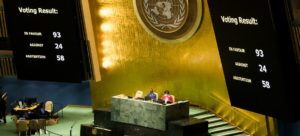Barbados will soon remove Queen Elizabeth as its head of state—but remain part of this organization that’s headed by the British monarch. Here’s what it all means.
In December 1966, Errol Barrow stood before the United Nations as the first prime minister of a newly independent Barbados. In his speech before the body, which had just admitted Barbados as a member, Barrow famously declared, “We will be friends of all, satellites to none.”
In the 55 years since, Barbados has been among the former British territories to declare independence. While the country did part ways with Britain, it continued to pledge fealty to Queen Elizabeth II as a Commonwealth realm—one of 16 independent countries that recognize the British monarch as its head of state. For some, she’s the colonel-in-chief of their armed forces—and in all of them, she has the rarely exercised authority to sign off on their laws or diplomatic appointments.
But on November 30, Barbados will remove Queen Elizabeth as its head of state and become a republic. It’s a watershed moment for the Caribbean nation that will officially set its own course without consulting the monarch. (The Caribbean’s ‘Little England’ has long wanted to free itself from British control.)
Yet still Barbados is not completely cutting its ties: The country remains a member of the Commonwealth of Nations, an organization composed mainly of former British colonies and headed by Queen Elizabeth. Member countries work together to protect the environment, boost trade, and support democracy through programs that help members manage their debts and natural resources, improve their economic competitiveness, and promote gender equality, among other initiatives.
It might seem like a confusing distinction. So how do members of the Commonwealth differ from Commonwealth realms? And what role does the queen play in their affairs? Here’s a look at the evolution of the organization that historian W. David McIntyre once described as “a loose association of states whose relationship with Britain and each other often defied definition.”
HOW THE COMMONWEALTH WAS FORMED
The Commonwealth of Nations was born out of the slow disintegration of the British Empire, which covered a fifth of the world’s land surface at its peak in the late 19th century. Its holdings spanned from Hong Kong to the Caribbean to a wide swath of southern and East Africa. Queen Victoria, whose reign was critical to consolidating the empire, became Empress of India in 1877.
But even as the empire expanded, some of its colonies grew frustrated with imperial oversight. In 1864 representatives from the three British colonies in modern-day Canada began to negotiate merging into one self-governing confederation. The territories—Nova Scotia, New Brunswick, and Canada—feared possible aggression from the United States and wanted to establish their own defense forces. They also sought free trade with their southern neighbor.
Anxious not to stoke another revolution like the one it had lost nearly a century earlier, Britain agreed to its colonists’ terms in July 1867. But it didn’t give up control of the territory: Instead, a united Canada became a British dominion. The distinction meant Canada could rule itself but its laws would still be subject to British oversight—meaning they could be vetoed at the monarch’s discretion. In subsequent decades, other predominantly white British colonies became dominions too, including Australia, New Zealand, Newfoundland, South Africa, and the Irish Free State (now the Republic of Ireland).
In the aftermath of World War I, however, rising nationalism in the dominions, which had fought alongside Britain, sparked a push for more than just self-governance. In 1926 Britain and the dominions agreed that they would all be equal in status, “united by a common allegiance to the Crown.” The declaration—formalized in 1931 with the Statute of Westminster—ushered in the official founding of the British Commonwealth of Nations.
TOWARD A MODERN COMMONWEALTH
But it would take about two more decades for the Commonwealth to evolve into its modern-day form—with a push from the independence movement in India. Although India was party to the 1926 talks, it didn’t sign on to the agreement that would have ensured its continued recognition of the British monarchy. Instead, a movement led by Mahatma Gandhi fought for full independence from colonial rule.
India finally won its independence from Britain in 1947. But it wasn’t ready to split entirely. Two years later, the newly sovereign country asked to join the British Commonwealth of Nations—with a few conditions. While India would accept King George VI as head of the Commonwealth, it would be the first country to join that didn’t swear allegiance to the crown.
Then Prime Minister Jawaharlal Nehru delivered a speech before India’s parliament that explained the decision: “In the world today where there are so many disruptive forces at work, where we are often on the verge of war, I think it is not a safe thing to encourage the breaking up of any association that one has.”
The member nations agreed to those conditions, and in 1949 they issued the London Declaration, allowing India, Pakistan, and Ceylon (modern-day Sri Lanka) to join “as free and equal members.” The declaration reformed the Commonwealth of Nations—one that would admit other independent nations without swearing allegiance to the crown.
MEMBERS OF THE COMMONWEALTH
Today there are 54 members of the Commonwealth of Nations, which tackles initiatives related to trade, environmental protections, education, and more. Members have no obligations to one another but are united through their common values—and, for most, their shared histories as former British colonies.
Commonwealth membership has seen significant churn in the more than 70 years since it was formed. Ireland withdrew from the organization in 1949 when it officially became a republic, while countries such as Fiji and Nigeria were suspended during periods of autocratic rule. Meanwhile, Mozambique and Rwanda became the only two countries without any historical ties to the British Empire to join the organization, in 1995 and 2009 respectively. Both countries sought to take advantage of the diplomatic and economic ties that membership would bring.
Many other countries joined the Commonwealth after winning independence from Britain in the mid-to-late 20th century—including Barbados, Cyprus, and Singapore. Papua New Guinea joined after gaining independence from Australia, a former British dominion. Following India’s lead, most chose not to swear fealty to the British monarchy.
However, some members still do recognize the queen. Known as the Commonwealth realms, these countries include Antigua and Barbuda, Australia, the Bahamas, Belize, Canada, Grenada, Jamaica, New Zealand, Papua New Guinea, St. Kitts and Nevis, St. Lucia, St. Vincent and the Grenadines, the Solomon Islands, Tuvalu, the United Kingdom—and until recently, Barbados. (Here’s why Queen Elizabeth’s portrait is still on the money of some former British colonies.)
THE BRITISH MONARCH’S ROLE IN THE COMMONWEALTH
The British monarch is not automatically the head of the Commonwealth. Although Queen Elizabeth succeeded King George, the position is technically not hereditary but selected by member nations. In 2018, the organization announced that Prince Charles will succeed his mother—but that may not hold true for future monarchs.
Either way, the role is symbolic. While a bureaucracy oversees the day-to-day work of the organization, Queen Elizabeth’s role has mainly been to reinforce the bonds among member nations by embarking on regular royal tours.
The monarch’s role is slightly different in the Commonwealth realms. Although they are not part of Britain—and they elect their own governments—these countries do still swear fealty to the British monarch. She is represented in the Commonwealth realms by governors-general, de facto heads of state who carry out ceremonial duties like approving legislation and appointing ministers, ambassadors, and judges.
Yet these roles too are largely ceremonial. Many countries select their own governor-general—who the queen then approves and appoints—and advise them on how to carry out their duties. But the Council on Foreign Relations notes that the governor-general does have the authority to override local governments in exceptional circumstances. In 1975, for instance, Australia’s governor-general John Kerr unilaterally dismissed Prime Minister Gough Whitlam to break a parliamentary deadlock, setting off a constitutional crisis.
MODERN RELEVANCE
In recent years, some of the Commonwealth realms have begun to consider making a change—particularly in the former colonies in the Caribbean and Pacific where younger people view the Commonwealth as a colonial relic.
In the 1970s, Guyana, Trinidad and Tobago, and Dominica all dropped the queen as their head of state while remaining in the Commonwealth. Other countries followed but until Barbados made its decision to remove the queen as its head of state in late 2020, the last country to do so was Mauritius in 1992.
Some speculate that Barbados’ decision could signal a new wave of republican sentiment. Richard Drayton, a professor of imperial history at King’s College London, told the New York Times in 2020 that Barbados’ decision to remove the queen as its head of state “could be a tipping point” for other countries such as Jamaica, St. Lucia, and St. Vincent and the Grenadines.
Meanwhile, even the former dominions have considered changing their relationship with the royal family. In a 1999 referendum, Australia very nearly did so with 45 percent of voters supporting removing Queen Elizabeth as head of state. A February 2021 survey found that 55 percent of Canadians believe the British royal family is no longer relevant to their lives—and half said that the queen should be removed as their head of state.
Yet even as countries debate these historic steps, their leaders echo the sentiments of Errol Barrow and Jawaharlal Nehru: In an increasingly globalized world, it’s critical to retain allies—even their former colonizer—through organizations like the Commonwealth of Nations.
“We look forward to continuing the relationship with the British monarch,” Barbados Prime Minister Mia Mottley said in an October address to Barbados Parliament members. Summarizing the inspiration behind the move to separate from the queen, she added, “The right to be able to chart the destiny of a people and to stand up and to defend them against all the odds is a sacred right which we claim on behalf of our people and which we express now with absolute confidence that irrespective of the challenges, cognizant of the opportunities, conscious of the need for unity, that Barbados shall move forward on the first of December as the newest republic in the global community of nations.”
_




